Do-it-yourself dry floor screed: we figure out how to do it right
Dry screed is one of the fastest ways to equip a perfectly flat base for the finish. Although its compressive strength is not as great as that of a traditional screed, it is sufficient even for rooms with high traffic. And despite the apparent fragility of the prefabricated structure, it is great for arranging the floor in even a garage. Therefore, let's take a closer look at what exactly is a dry screed and how to do it correctly.
Content
Type of screed: what is the basis?
Here is what this screed is:
A floor from a dry coupler is a wonderful soundproofing agent. Advantages - weight:
Manufacturer Knauf, for example, distinguishes 4 types of such a screed:
"Alpha";
Beta in two versions;
"Vega";
"Gamma".
By the way, arranging a dry screed in wet rooms is undesirable - porcelain stoneware is inherently a good absorbent, i.e. well draws in any vapor from the air. Perhaps this is the only significant drawback.
Leveling sheets: GVL, GKVL, or chipboard?
So what can be used as a floor element? The sheet material for the dry screed is also different - these are plasterboard, and gypsum fiber sheets, and plywood, and OSB. The choice depends on the wet-temperature conditions of the room itself, where the floor is laid.
Dry screed is made of such floor elements:
- GVL, gypsum fiber sheets;
- GVLV, moisture resistant gypsum sheets;
- SHG, gypsum sheets;
- Particleboard, chipboard;
- OSB, wood-based particle boards;
- moisture resistant plywood.
The most effective to date is the comprehensive OP 135 system from Knauf. This is a whole set of materials for installing a dry prefabricated floor without voids, with good heat and sound insulating qualities. Such a screed is traditionally assembled from small-format "super sheets" GVLV - moisture-proof drywall. All elements of the system are manufactured using modern technology and reliable.
But the GSP material is valuable for its durability and environmental friendliness. Such a floor element should be put in two layers, gluing sheets with ordinary PVA glue and fixing additionally with self-tapping screws.
Cons of using SHG sheets: gypsum dust when cutting and weight. That is why many construction crews refuse to work with this material, because when sawing a lot of fine dust, because of which almost nothing is visible in the room. The only way out is a jigsaw with a dust collector, and not everyone has such a tool.
The problem is that almost any kind of slabs visually can look quite even, but in fact they are usually far from ideal. In addition, there may indeed be too much dust from cutting such material. Therefore, experimenting with some new material is not worth it — the provided choice is enough.
But we note that in a dry screed, in addition to floor and backfill elements, it is additionally possible to use polystyrene plates that provide heat and sound protection. Especially if the backfill comes with rather low rates for this part, like quartz sand, for example.
Dry screed is one of the fastest ways to equip a perfectly flat base for the finish. Details on how to perform the work yourself, you will learn from the material:https://floor.expertexpro.com/en/viravniv-stazhka/suxaya-styazhka-pola-svoimi-rukami.html.
The thickness of the dry screed directly depends on the unevenness of the floor and the presence of individual communications in it. The standard is 30-50 mm, but a large height is also possible, at which it is already desirable to lay the plates in two layers for added strength.
Dry backfill: learning to understand quality
The thickness of the dry screed can be any - it depends on the unevenness of the base and the availability of utilities. On average - about 3-5 cm, but it can also be higher than 6 cm, which already requires additional reinforcement with another layer of plates. And when arranging a dry screed, it is not necessary to use expanded clay alone as a filling - it can be screenings of its production, quartz, silica or expanded perlite sand, fine-grained slag. All these materials have low hygroscopicity, no shrinkage and high porosity.
As a dry backfill, you can use everything that meets the following requirements:
Therefore, screening of claydite production, quartz, siliceous and perlite sands, and even fine-grained slag are also suitable in this category - if only these bulk materials had a maximum size of 2-5 mm and a humidity of about 1%. Please note that the sizes of the backfill elements have their own term - "fraction".
Option # 1 - expanded clay
The most common filler for dry screeds is expanded clay. These are simply well-fired clay granules that have a porous surface and light weight. Let's dwell on how to choose expanded clay for a dry screed device:
- Paragraph 1. The optimal grain size for dry screed is 5 mm. If you are trying to sell those that are larger, this threatens a complete violation of technology.
- Point 2. Carefully inspect the grains in the bag. Among them will come across larger and smaller. So, the difference between them should be minimal, otherwise refuse such backfill. It will simply begin to “cobble” over time, because smaller granules will begin to sag between large ones. The perfect mix is one size.
- Point 3. Take the material without any impurities of dust or sand, i.e. clean. If you take such a backfill, then the floors will creak godlessly. For this, it is better to buy loose granules, but, of course, you can also in closed bags. But then see that they are not dirty, because in such dust will be a lot.
- Item 4. Now measure the weight of the granules. Expanded clay should be light, porous in section. And bags with pure expanded clay are also light in weight.
It is also important to correctly calculate the expanded clay layer. So, the minimum is 3-4 cm.
Option # 2 - vermiculite
Vermiculite is a natural laminate. To make dry filling from it, vermiculite is heated and golden and silver sticks similar to worms are obtained. Hence the name - vermiculus, which is translated from Latin as "worm".
As a backfill, vermiculite is good because it has a very light weight. So, a cubic meter of this breed weighs only 160 kg, and therefore the load on the overlap is minimal. For comparison: one cubic meter of expanded clay weighs 250-600 kg.
But for the device of a dry screed, only expanded vermiculite is suitable, because ordinary has a high coefficient of water absorption. Here is the process of working with this material:
Expanded clay has remarkable heat-insulating properties - only 10 cm of expanded clay aggregate layer is warmer than 30 cm of wood and 100 cm of brick wall. It is very important to use this material correctly in the screed and we will tell you about this in the next article:https://floor.expertexpro.com/en/viravniv-stazhka/styazhka-pola-s-keramzitom.html.
Option # 3 - perlite
Perlite is a volcanic rock. For the installation of dry screeds, it is used in expanded form, which is obtained by thermal shock at 1000 ° C - so almost all moisture is removed from the material. Perlite sand is also used as backfill:
Option # 4 - Compavit
Produces "Compavit" Belarusian company "Vipol". Note that such a backfill is much more difficult to fake or use incorrectly than ordinary kerasmite, which today is often taken in the wrong fraction, and even with dust.
In Kompavit, the backfill base is expanded clay, round, with a granule size of 1-4 mm, but more dense. The deformation and subsidence of such floors is reduced to zero. And this sand is not at all what is obtained from ordinary crushed expanded clay and which the market actively offers, pay attention. This material has good heat and sound insulation performance.
Option # 5 - no backfill
Dry screed is also made without any backfill at all. For example, if the base is fairly even, then it is enough to close it with tightly laid plates of extruded polystyrene foam.
Step-by-step technology of work
For dry screed, guide profiles are primarily required. We put the first one against the wall, and all subsequent ones - one and a half meters from each other. We have profiles strictly parallel to each other. If you need to raise them higher, we place boards or pieces of the same plates under them. Supports under the profiles are located at least after 70 cm.
Lay sheets on a dry screed start from the door - it is not advisable to walk on them until the end of laying. And to move around expanded clay, use unnecessary sections from plates - such “islands” for yourself. The laying procedure is approximately the following:
On the very first sheets, it is necessary to cut the folds so that the sheets lie evenly and do not penetrate the expanded clay backfill. You can mount them in different ways:
Instead of the usual plastic film, as a waterproofing, you can use moisture-proof plywood:
Beacons after the end of the dry screed device must be removed. The fact is that the screed will sag a little over time, and the lighthouses, due to their rigidity, will remain in place. Raw claydite is especially dangerous in this regard - if the bedding is not sufficiently dried, serious floor deformation cannot be avoided in the future.
That is why the proper installation of a dry screed is so important. After all, this is the key to longevity, strength and safety for human health.
If you have chosen a laminate as a floor covering, then it will be useful for you to find out about various ways of leveling a wooden floor. On how to measure the curvature of the floor and the comparison of the three methods of work, you will find on our website:https://floor.expertexpro.com/en/viravniv-stazhka/vyravnivanie-derevyannogo-pola-pod-laminat.html.
KNAUF dry screed
Of all the dry bulk floors, the German company Knauf leads the market, and rightly so far, only good reviews about its products. The manufacturer Knauf traditionally uses only environmentally friendly material, with high quality. These are excellent sound and heat insulating properties, complete fire safety and valuable speed of the screed itself.
The Knauf bulk floor has the following pie: PVC film as a dividing and insulating layer, leveling expanded clay and GVL sheets. The standard sizes of Knauf sheets are 250x120x1 cm, or 250x120x1.25 cm. There are also the so-called Knauf super sheets 2 cm thick on sale, which are glued on sheets of 150x50x1 cm. In their perimeter there are folds of 5 cm.
Like this:
Knauf dry floors are used as a compensating layer when the backfill thickness does not exceed 15 cm. And to level the floor in rooms with high humidity, such as a kitchen or a bathroom, use special moisture-resistant sheets.
For waterproofing, you can take a simple plastic film of 200 microns. It must be laid correctly, with a run of 6-7 cm on the walls and an overlap of 20 cm more.
Pseudo-Knauf: are they doing the right thing in Russia?
The Knauf superfloor with dry screed technology has significant drawbacks, for all their advantages. And the most serious of them is the lack of a professional tool in Russia. It is not difficult to purchase expanded clay and sheets from the catalog, it’s even easier to watch training videos, but the tool is simply not imported into the country.
And the fact that in our country any Western technology likes to reduce the cost and simplify is a well-known fact.So, initially the German company KNAUF conceived such a floor cake: dry fine-grained backfill as the lower layer and gypsum boards from the top as the top, without any beacons inside the screed. Instead, reusable guides should be used to align the screed, and they must be removed. This is a special equipment that is not cheap, and to use which you need a certain skill. That is why Russia has simplified this point - they put disposable metal beacons right in the thickness of the screed, where they are left. And of course, any finisher will cope with such work.
But in fact, then the screed is no different from the same asphalt that was laid through the tram tracks - in the first years they will remain below the surface, but later they will begin to become bare due to the fact that any material sags. The same thing happens with a dry screed: over the years, the lighthouses remaining in the bulk of the backfill begin to abut against the GVL sheets. And those, on the contrary, will bend. To all, the lighthouse left in the backfill serves as such a sound bridge, which negates the entire soundproofing of the floor, while the manufacturer promises its improvement by 27-30%.
Related video:
In addition, homemade beacons are placed on a plaster mortar. But it takes a day to dry completely, while the working team plans to finish everything on the same day. And expanded clay just gets enough sleep on the base, where it comes into contact with raw "cakes". Such slides dry, covered and covered with sheets, then even more slowly, which is why mold and fungus often arise. And this will become noticeable far from immediately.
Another violation: the use, instead of special filling, of coarse-grained construction expanded clay. So cheaper, no doubt. But the original filling is designed so that smaller granules fill the voids between the larger ones, and the ratio of their sizes is even calculated by a special formula. All this gives a high density of the backfill layer, and in the first case there is a risk of considerable voids, which then give a “bump” and deformation of the entire screed. In addition, expanded clay for dry screeds has its own strict requirements for density and roundness of forms.
Note that today there are only two types of backfill, specially designed for German dry screed - this is “Knauf” and “Compavit”. Compavit is officially authorized by the company Knauf. The use of any other material is a certain risk, and no one will give a guarantee for such a screed.
Nevertheless, a dry screed is the cheapest and fastest way to level the surface, which horizontal tongue will not turn to call. It is only important not to trust 100% advertising and business sellers, but to turn on your own head and carefully monitor that the future floor structure is made as much as possible consistent with the original technology.

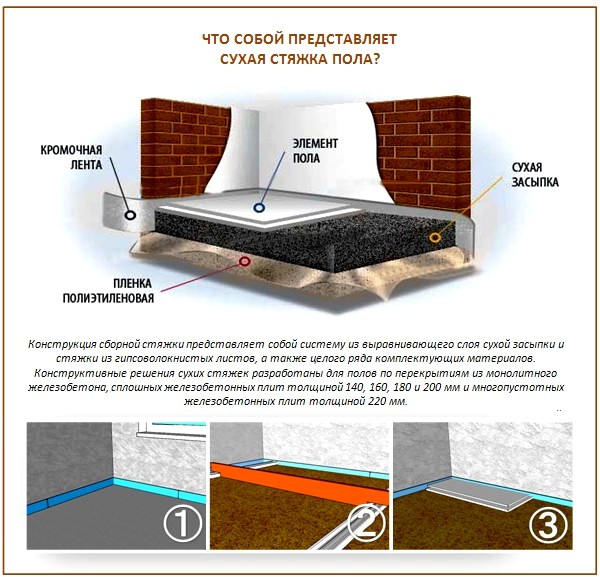
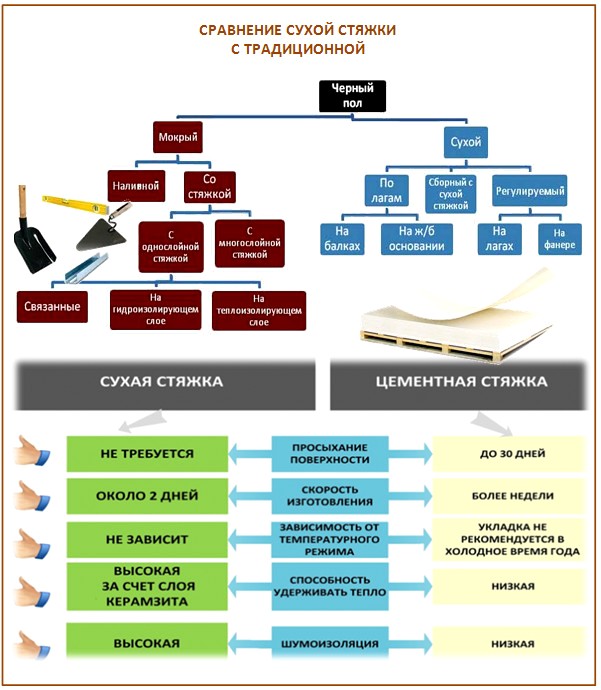

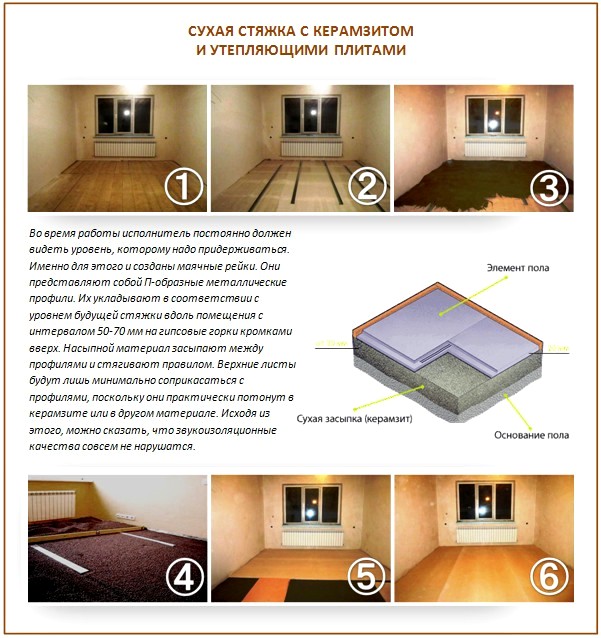
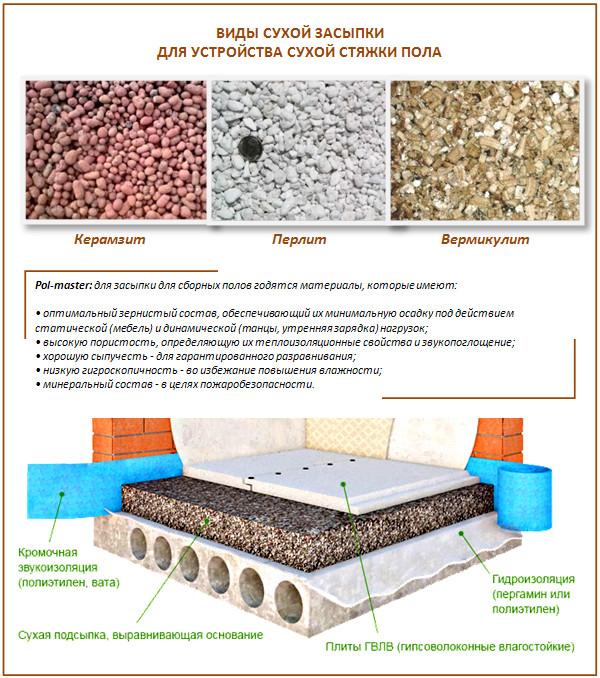
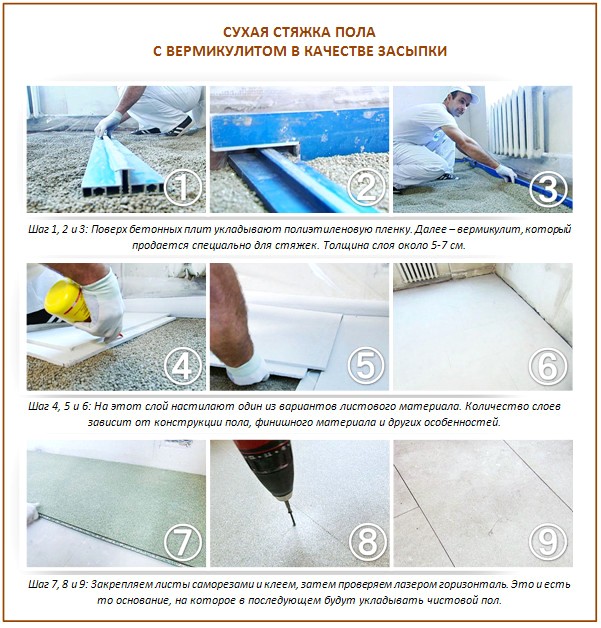

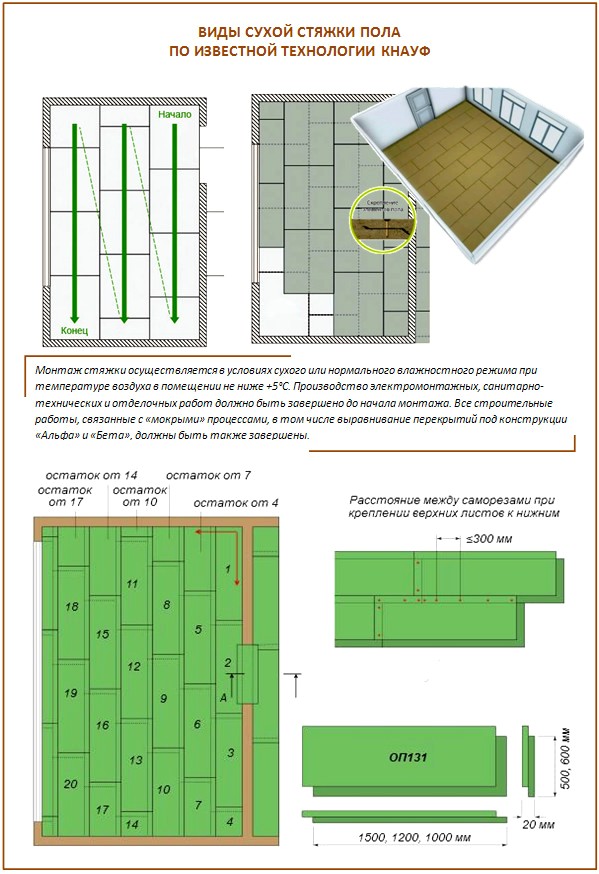
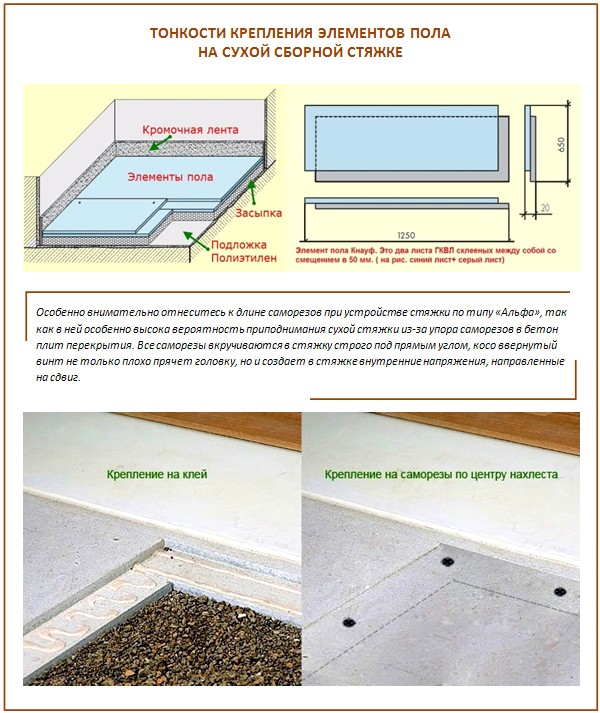
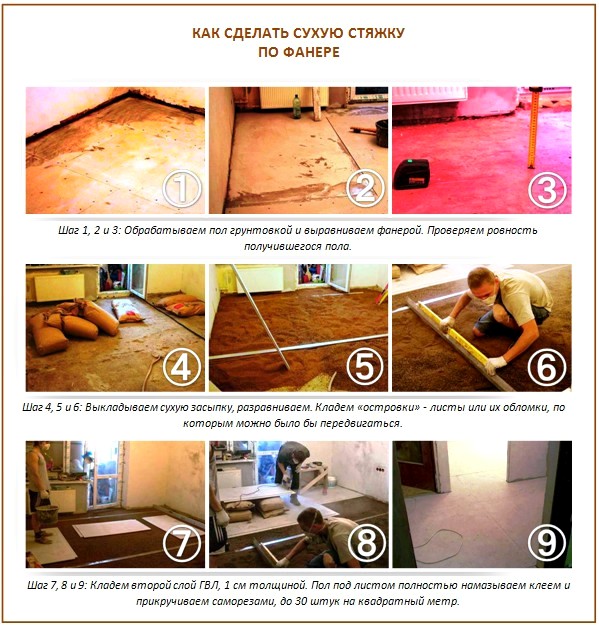
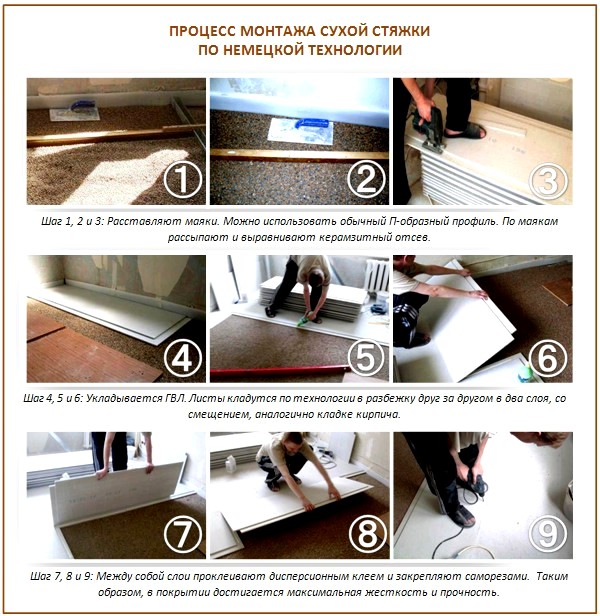
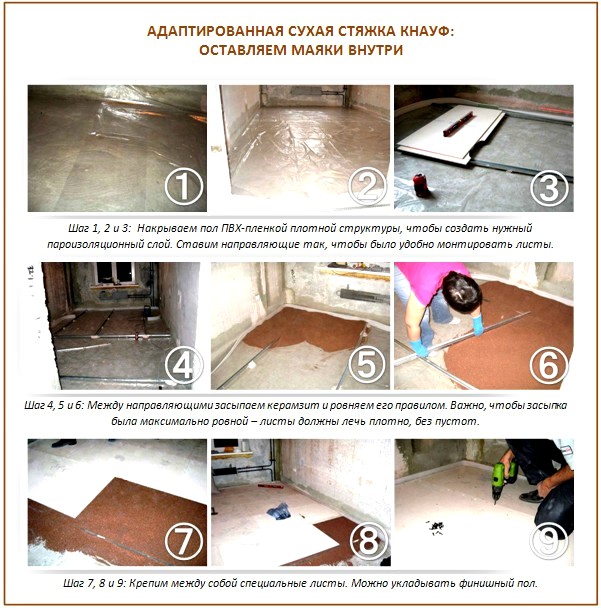



7 comments